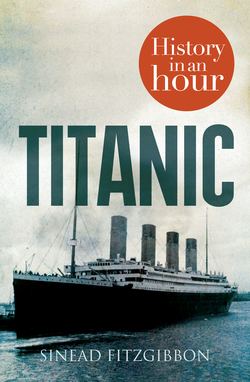Читать книгу Titanic: History in an Hour - Sinead Fitzgibbon - Страница 7
ОглавлениеRMS Titanic: A Ship Unlike Any Other
While the Olympic sailed for England, Titanic took her place in the fitting-out basin. The installation of machinery, equipment and fixtures was a painstaking process, which would take ten months and several million man-hours to complete.
Titanic was furnished with twenty-nine massive boilers and three engines, which were serviced by four huge smokestacks or funnels. This state-of-the-art machinery allowed for an almost unprecedented top speed of 22.5 knots (or nautical miles per hour), which was also no doubt assisted by her three gigantic propellers, the largest of which measured 23.5 feet in diameter and weighed around 15 tonnes. So gigantic were the propellers (pictured below) a team of twenty horses was employed to pull them from the workshop prior to fitting.
Titanic’s Giant Propellers, at the Harland & Wolff shipyard 31 May 1911 Photograph by Robert John Welch (1859–1936), official photographer for Harland & Wolff
As RMS Titanic slowly began to take shape, it became clear that she would outshine even the Olympic. Although almost identical in design, the Titanic was a full 1,004 tonnes larger than her elder sibling. At 882.75 feet in length and 92 feet in width, her dimensions were indeed awe-inspiring. With her four funnels in place, her height was measured at a staggering 175 feet, and her weight was a massive 46,000 tonnes. At full capacity, she could accommodate 2,600 passengers and a crew of 940.
The sheer scale of the new ship was conveyed in an article in the Southampton Pictorial, its author having viewed the berth in Southampton, prior to her maiden voyage.
Perhaps the most striking features of the great inert mass of metal are the four giant funnels – huge tawny brown and black capped elliptical cylinders of steel, dominating the other shipping in the port and dwarfing into insignificance the sheds on the quayside.
RMS Titanic, it seemed, was certainly worthy of her name.
In a Class of its Own
If Titanic looked impressive from the outside, her interior appointments were even more extraordinary. The first-class areas of the ship were showcases of Edwardian splendour. Not one, but two staircases curved down from the upper to the lower first-class decks. One, known as the Grand Staircase was positioned near the front of the ship (forward) and the other towards the back (aft). The Olympic’s forward staircase – identical to Titanic’s – is pictured below.
Both stairways boasted elaborately carved wooden banisters and beautiful wrought-iron balustrades. An exquisitely decorated clock, set into an ornate wooden panel, was placed on the landing at the top of the front staircase. The walls were lined with polished oak panelling inlaid with mother-of-pearl, and these were illuminated by a flood of natural light which streamed through the huge glass dome crowning the forward staircase. Ornate gold-plated light fixtures glittered from the ceilings at night.
Forward Grand Staircase on the RMS Olympic
The first-class dining saloon was yet another sight to behold. Measuring over 100 feet in length, with tall alcoves housing arched and leaded windows, it was by far the largest room on the ship. It would become the hub of evening social activities during the fateful maiden voyage. If passengers grew tired of the oversized dining room, however, the Verandah Café with its ivy-covered trellises, and the Café Parisien (pictured below) complete with genuine French waiters, offered a more intimate dining experience.
Titanic’s Café Parisien Photography by Robert John Welch, official photographer for Harland & Wolff
Other amenities offered to first-class passengers on RMS Titanic included a reading and writing room, which was stocked with an impressive library (pictured below). Enclosed promenade decks allowed for exercise even in inclement weather, along with a large swimming pool, and a well-equipped gymnasium. There were also some decadent Turkish Baths and a barber shop.
Reading Room for First-Class Passengers
One first-class passenger, Mrs Ida Strauss – wife of Isidor Strauss, the founder of Macy’s department store – described her first impressions of the Titanic in a letter to a friend: ‘But, what a ship! So huge and so magnificently appointed. Our rooms are furnished in the best of taste and most luxuriously and they are really rooms, not cabins.’
It was not just the first-class accommodation that was impressive, somewhat unusually for the time, second- and third-class passengers also travelled in style. While nowhere near the ostentatious magnificence of first class, Titanic’s second- and third-class areas were still a considerable improvement on the norm. As a rule, the second-class accommodation on Titanic was equivalent to first class on other ships, while third class equated to second class on other liners.
Lawrence Beesley, a teacher and one of the few second-class male passengers lucky enough to survive the disaster, described the ship in detail in a letter to his son:
The ship is like a palace! There is an uninterrupted deck run of 165 yards for exercise and a ripping swimming bath, gymnasium and squash racket court & huge lounge & surrounding verandahs. My cabin is ripping, hot and cold water and a very comfy looking bed and plenty of room.
Similarly, another second-class passenger, 31-year-old Harvey Collyer, wrote to his parents:
So far we are having a delightful trip the weather is beautiful the ship magnificent . . . It’s like a floating town. I can tell you we do swank we shall miss it on the trains as we go third on them. You would not imagine you were on a ship. There is hardly any motion she is so large we have not felt sick yet.
All in all, it seems that to travel on RMS Titanic was to travel in unprecedented comfort, regardless of the class of ticket.
